Abstract
Endothelial cells respond to several cytokines by a rapid increase in expression of the adhesion molecules E-selectin and intercellular adhesion molecule-1 (ICAM-1), followed by a gradual decline. The fate of these molecules, which was so far unknown, was studied. Specific sandwich ELISA for the detection of soluble (s)E-selectin and sICAM-1 were developed. In supernatant, centrifuged 3 hr at 100,000 g to remove microparticles, from human umbilical vein endothelial cells (HUVEC) activated with tumour necrosis factor (TNF), interleukin-1 (IL-1) or lipopolysaccharide (LPS), E-selectin and ICAM-1 molecules could be detected. Biochemical analysis revealed that sE-selectin migrated as a band of approximately 94,000 MW. The amount of soluble adhesion molecules released was directly correlated with cell surface expression. Maximal release of E-selectin was observed 6-12 hr after activation of HUVEC and decreased to below detection limit 24 hr after activation. After activation, release of ICAM-1 gradually increased with ICAM-1 cell surface expression, and reached a plateau after 24 hr, which was constant for 3 days. Since E-selectin and ICAM-1 are highly expressed at inflammatory sites, the resulting high concentrations of released E-selectin and ICAM-1 may affect interactions of leucocytes with endothelial cells. The physiological role, however, of the release of E-selectin and ICAM-1 remains to be elucidated.
Full text
PDF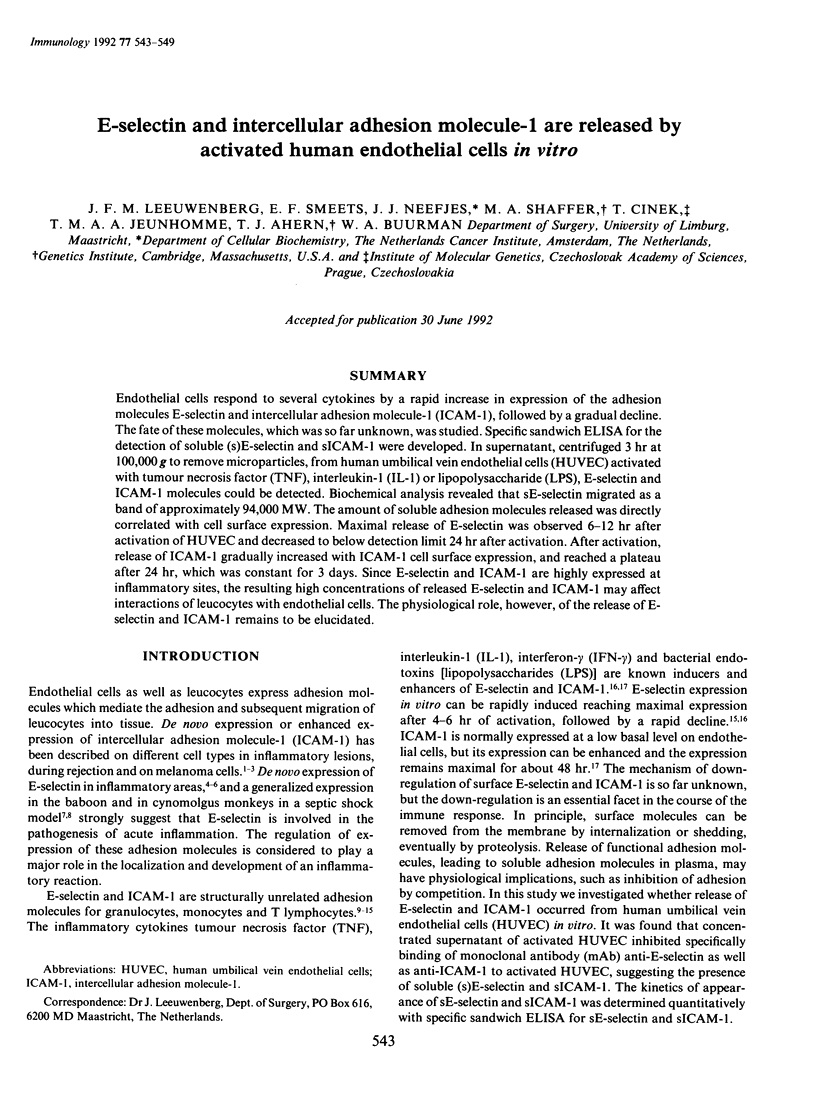
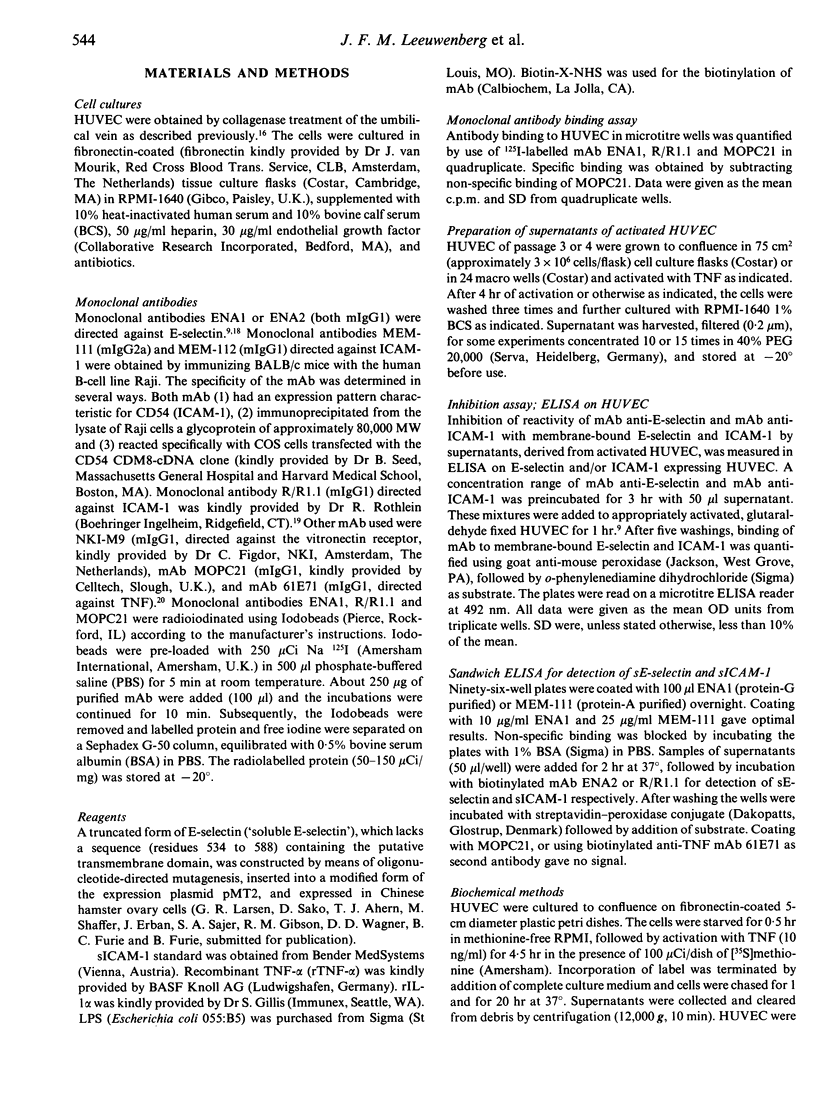
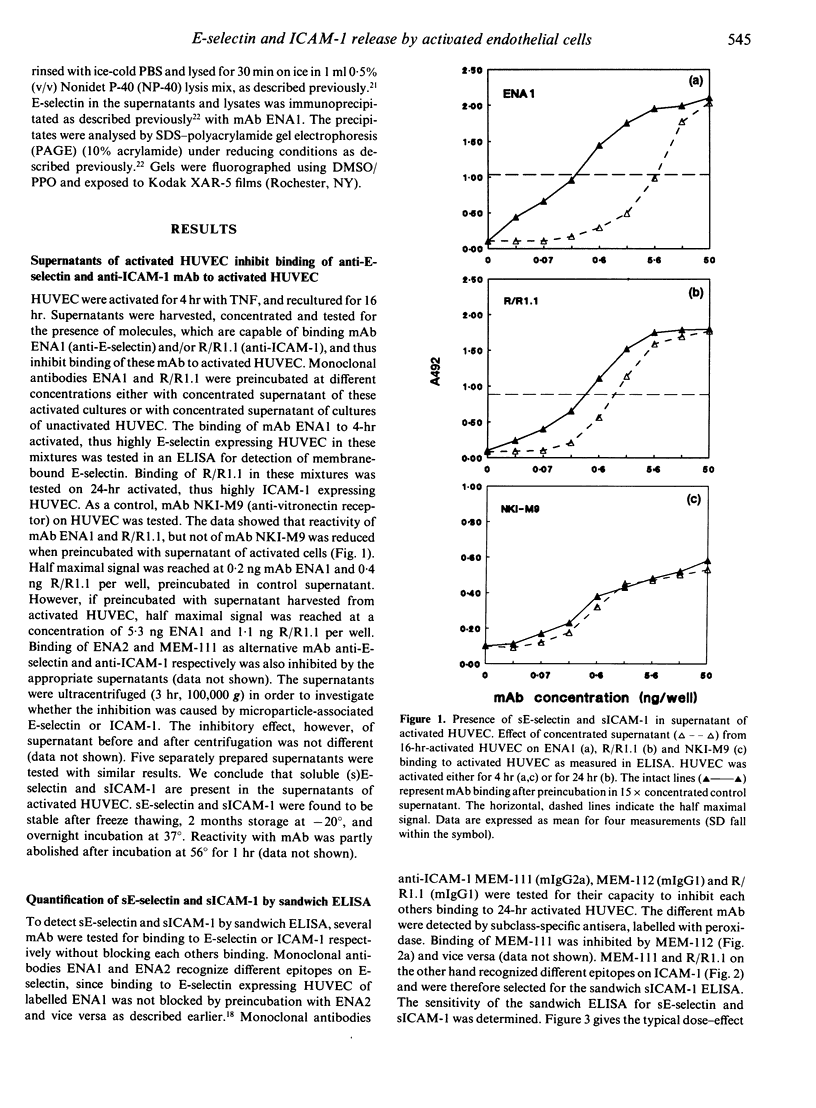
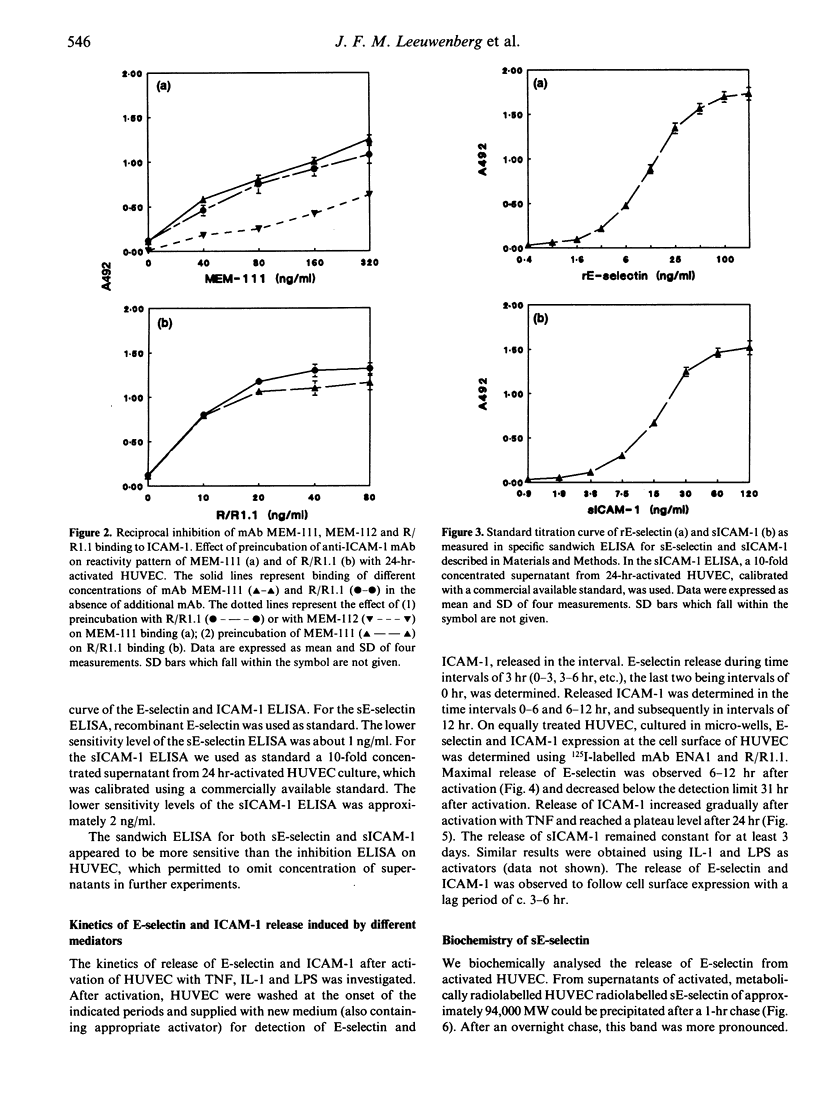
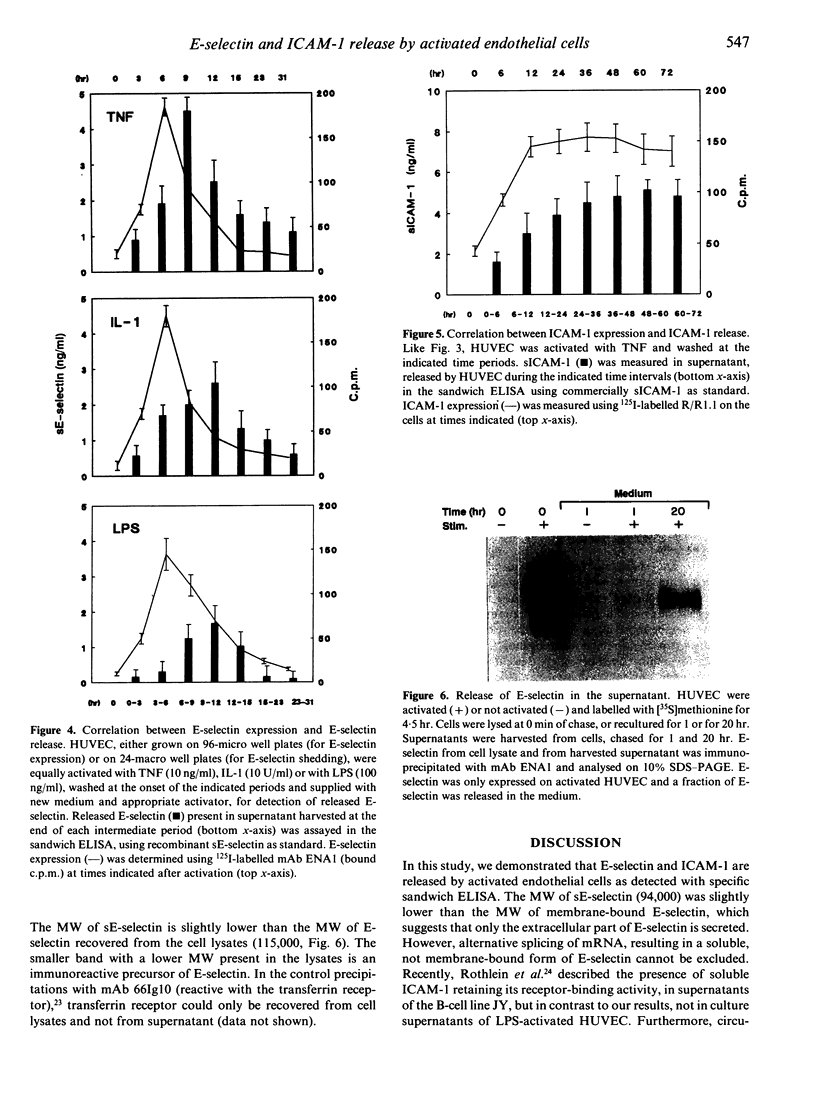
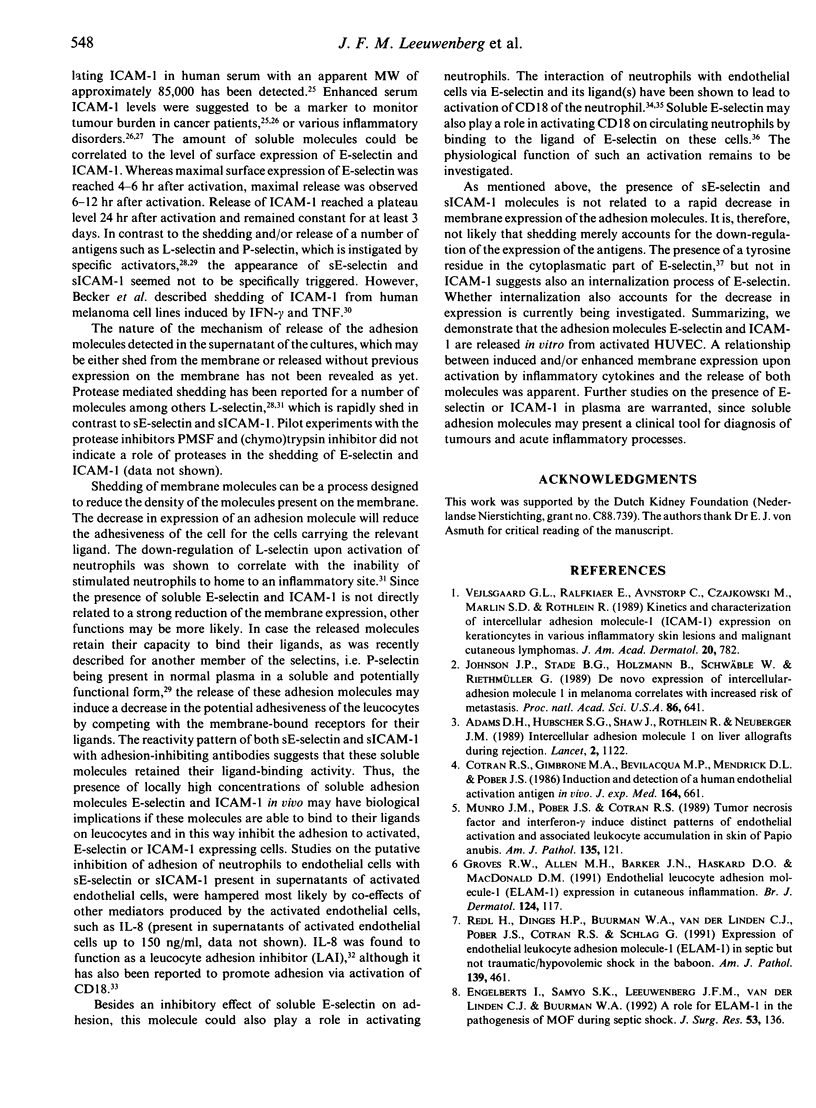
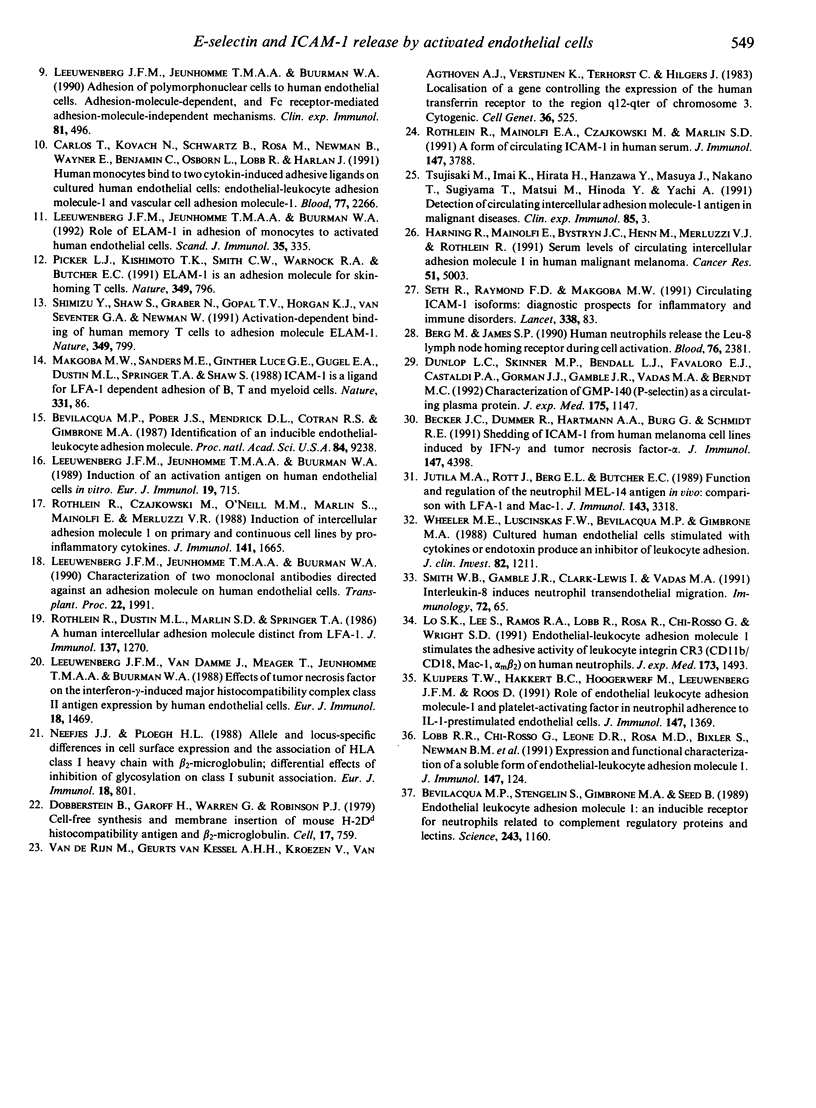
Images in this article
Selected References
These references are in PubMed. This may not be the complete list of references from this article.
- Adams D. H., Hubscher S. G., Shaw J., Rothlein R., Neuberger J. M. Intercellular adhesion molecule 1 on liver allografts during rejection. Lancet. 1989 Nov 11;2(8672):1122–1125. doi: 10.1016/s0140-6736(89)91489-x. [DOI] [PubMed] [Google Scholar]
- Becker J. C., Dummer R., Hartmann A. A., Burg G., Schmidt R. E. Shedding of ICAM-1 from human melanoma cell lines induced by IFN-gamma and tumor necrosis factor-alpha. Functional consequences on cell-mediated cytotoxicity. J Immunol. 1991 Dec 15;147(12):4398–4401. [PubMed] [Google Scholar]
- Berg M., James S. P. Human neutrophils release the Leu-8 lymph node homing receptor during cell activation. Blood. 1990 Dec 1;76(11):2381–2388. [PubMed] [Google Scholar]
- Bevilacqua M. P., Pober J. S., Mendrick D. L., Cotran R. S., Gimbrone M. A., Jr Identification of an inducible endothelial-leukocyte adhesion molecule. Proc Natl Acad Sci U S A. 1987 Dec;84(24):9238–9242. doi: 10.1073/pnas.84.24.9238. [DOI] [PMC free article] [PubMed] [Google Scholar]
- Bevilacqua M. P., Stengelin S., Gimbrone M. A., Jr, Seed B. Endothelial leukocyte adhesion molecule 1: an inducible receptor for neutrophils related to complement regulatory proteins and lectins. Science. 1989 Mar 3;243(4895):1160–1165. doi: 10.1126/science.2466335. [DOI] [PubMed] [Google Scholar]
- Carlos T., Kovach N., Schwartz B., Rosa M., Newman B., Wayner E., Benjamin C., Osborn L., Lobb R., Harlan J. Human monocytes bind to two cytokine-induced adhesive ligands on cultured human endothelial cells: endothelial-leukocyte adhesion molecule-1 and vascular cell adhesion molecule-1. Blood. 1991 May 15;77(10):2266–2271. [PubMed] [Google Scholar]
- Cotran R. S., Gimbrone M. A., Jr, Bevilacqua M. P., Mendrick D. L., Pober J. S. Induction and detection of a human endothelial activation antigen in vivo. J Exp Med. 1986 Aug 1;164(2):661–666. doi: 10.1084/jem.164.2.661. [DOI] [PMC free article] [PubMed] [Google Scholar]
- Dobberstein B., Garoff H., Warren G., Robinson P. J. Cell-free synthesis and membrane insertion of mouse H-2Dd histocompatibility antigen and beta 2-microglobulin. Cell. 1979 Aug;17(4):759–769. doi: 10.1016/0092-8674(79)90316-7. [DOI] [PubMed] [Google Scholar]
- Dunlop L. C., Skinner M. P., Bendall L. J., Favaloro E. J., Castaldi P. A., Gorman J. J., Gamble J. R., Vadas M. A., Berndt M. C. Characterization of GMP-140 (P-selectin) as a circulating plasma protein. J Exp Med. 1992 Apr 1;175(4):1147–1150. doi: 10.1084/jem.175.4.1147. [DOI] [PMC free article] [PubMed] [Google Scholar]
- Dustin M. L., Springer T. A. Lymphocyte function-associated antigen-1 (LFA-1) interaction with intercellular adhesion molecule-1 (ICAM-1) is one of at least three mechanisms for lymphocyte adhesion to cultured endothelial cells. J Cell Biol. 1988 Jul;107(1):321–331. doi: 10.1083/jcb.107.1.321. [DOI] [PMC free article] [PubMed] [Google Scholar]
- Engelberts I., Samyo S. K., Leeuwenberg J. F., van der Linden C. J., Buurman W. A. A role for ELAM-1 in the pathogenesis of MOF during septic shock. J Surg Res. 1992 Aug;53(2):136–144. doi: 10.1016/0022-4804(92)90025-u. [DOI] [PubMed] [Google Scholar]
- Groves R. W., Allen M. H., Barker J. N., Haskard D. O., MacDonald D. M. Endothelial leucocyte adhesion molecule-1 (ELAM-1) expression in cutaneous inflammation. Br J Dermatol. 1991 Feb;124(2):117–123. doi: 10.1111/j.1365-2133.1991.tb00419.x. [DOI] [PubMed] [Google Scholar]
- Harning R., Mainolfi E., Bystryn J. C., Henn M., Merluzzi V. J., Rothlein R. Serum levels of circulating intercellular adhesion molecule 1 in human malignant melanoma. Cancer Res. 1991 Sep 15;51(18):5003–5005. [PubMed] [Google Scholar]
- Johnson J. P., Stade B. G., Holzmann B., Schwäble W., Riethmüller G. De novo expression of intercellular-adhesion molecule 1 in melanoma correlates with increased risk of metastasis. Proc Natl Acad Sci U S A. 1989 Jan;86(2):641–644. doi: 10.1073/pnas.86.2.641. [DOI] [PMC free article] [PubMed] [Google Scholar]
- Jutila M. A., Rott L., Berg E. L., Butcher E. C. Function and regulation of the neutrophil MEL-14 antigen in vivo: comparison with LFA-1 and MAC-1. J Immunol. 1989 Nov 15;143(10):3318–3324. [PubMed] [Google Scholar]
- Kuijpers T. W., Hakkert B. C., Hoogerwerf M., Leeuwenberg J. F., Roos D. Role of endothelial leukocyte adhesion molecule-1 and platelet-activating factor in neutrophil adherence to IL-1-prestimulated endothelial cells. Endothelial leukocyte adhesion molecule-1-mediated CD18 activation. J Immunol. 1991 Aug 15;147(4):1369–1376. [PubMed] [Google Scholar]
- Leeuwenberg J. F., Jeunhomme G. M., Buurman W. A. Adhesion of polymorphonuclear cells to human endothelial cells. Adhesion-molecule-dependent, and Fc receptor-mediated adhesion-molecule-independent mechanisms. Clin Exp Immunol. 1990 Sep;81(3):496–500. doi: 10.1111/j.1365-2249.1990.tb05362.x. [DOI] [PMC free article] [PubMed] [Google Scholar]
- Leeuwenberg J. F., Jeunhomme G. M., Buurman W. A. Characterization of two monoclonal antibodies directed against an adhesion molecule on human endothelial cells. Transplant Proc. 1990 Aug;22(4):1991–1993. [PubMed] [Google Scholar]
- Leeuwenberg J. F., Jeunhomme T. M., Buurman W. A. Induction of an activation antigen on human endothelial cells in vitro. Eur J Immunol. 1989 Apr;19(4):715–720. doi: 10.1002/eji.1830190422. [DOI] [PubMed] [Google Scholar]
- Leeuwenberg J. F., Jeunhomme T. M., Buurman W. A. Role of ELAM-1 in adhesion of monocytes to activated human endothelial cells. Scand J Immunol. 1992 Mar;35(3):335–341. doi: 10.1111/j.1365-3083.1992.tb02866.x. [DOI] [PubMed] [Google Scholar]
- Leeuwenberg J. F., Van Damme J., Meager T., Jeunhomme T. M., Buurman W. A. Effects of tumor necrosis factor on the interferon-gamma-induced major histocompatibility complex class II antigen expression by human endothelial cells. Eur J Immunol. 1988 Sep;18(9):1469–1472. doi: 10.1002/eji.1830180925. [DOI] [PubMed] [Google Scholar]
- Lo S. K., Lee S., Ramos R. A., Lobb R., Rosa M., Chi-Rosso G., Wright S. D. Endothelial-leukocyte adhesion molecule 1 stimulates the adhesive activity of leukocyte integrin CR3 (CD11b/CD18, Mac-1, alpha m beta 2) on human neutrophils. J Exp Med. 1991 Jun 1;173(6):1493–1500. doi: 10.1084/jem.173.6.1493. [DOI] [PMC free article] [PubMed] [Google Scholar]
- Lobb R. R., Chi-Rosso G., Leone D. R., Rosa M. D., Bixler S., Newman B. M., Luhowskyj S., Benjamin C. D., Dougas I. G., Goelz S. E. Expression and functional characterization of a soluble form of endothelial-leukocyte adhesion molecule 1. J Immunol. 1991 Jul 1;147(1):124–129. [PubMed] [Google Scholar]
- Munro J. M., Pober J. S., Cotran R. S. Tumor necrosis factor and interferon-gamma induce distinct patterns of endothelial activation and associated leukocyte accumulation in skin of Papio anubis. Am J Pathol. 1989 Jul;135(1):121–133. [PMC free article] [PubMed] [Google Scholar]
- Neefjes J. J., Ploegh H. L. Allele and locus-specific differences in cell surface expression and the association of HLA class I heavy chain with beta 2-microglobulin: differential effects of inhibition of glycosylation on class I subunit association. Eur J Immunol. 1988 May;18(5):801–810. doi: 10.1002/eji.1830180522. [DOI] [PubMed] [Google Scholar]
- Picker L. J., Kishimoto T. K., Smith C. W., Warnock R. A., Butcher E. C. ELAM-1 is an adhesion molecule for skin-homing T cells. Nature. 1991 Feb 28;349(6312):796–799. doi: 10.1038/349796a0. [DOI] [PubMed] [Google Scholar]
- Redl H., Dinges H. P., Buurman W. A., van der Linden C. J., Pober J. S., Cotran R. S., Schlag G. Expression of endothelial leukocyte adhesion molecule-1 in septic but not traumatic/hypovolemic shock in the baboon. Am J Pathol. 1991 Aug;139(2):461–466. [PMC free article] [PubMed] [Google Scholar]
- Rothlein R., Czajkowski M., O'Neill M. M., Marlin S. D., Mainolfi E., Merluzzi V. J. Induction of intercellular adhesion molecule 1 on primary and continuous cell lines by pro-inflammatory cytokines. Regulation by pharmacologic agents and neutralizing antibodies. J Immunol. 1988 Sep 1;141(5):1665–1669. [PubMed] [Google Scholar]
- Rothlein R., Dustin M. L., Marlin S. D., Springer T. A. A human intercellular adhesion molecule (ICAM-1) distinct from LFA-1. J Immunol. 1986 Aug 15;137(4):1270–1274. [PubMed] [Google Scholar]
- Rothlein R., Mainolfi E. A., Czajkowski M., Marlin S. D. A form of circulating ICAM-1 in human serum. J Immunol. 1991 Dec 1;147(11):3788–3793. [PubMed] [Google Scholar]
- Seth R., Raymond F. D., Makgoba M. W. Circulating ICAM-1 isoforms: diagnostic prospects for inflammatory and immune disorders. Lancet. 1991 Jul 13;338(8759):83–84. doi: 10.1016/0140-6736(91)90077-3. [DOI] [PubMed] [Google Scholar]
- Shimizu Y., Shaw S., Graber N., Gopal T. V., Horgan K. J., Van Seventer G. A., Newman W. Activation-independent binding of human memory T cells to adhesion molecule ELAM-1. Nature. 1991 Feb 28;349(6312):799–802. doi: 10.1038/349799a0. [DOI] [PubMed] [Google Scholar]
- Smith W. B., Gamble J. R., Clark-Lewis I., Vadas M. A. Interleukin-8 induces neutrophil transendothelial migration. Immunology. 1991 Jan;72(1):65–72. [PMC free article] [PubMed] [Google Scholar]
- Vejlsgaard G. L., Ralfkiaer E., Avnstorp C., Czajkowski M., Marlin S. D., Rothlein R. Kinetics and characterization of intercellular adhesion molecule-1 (ICAM-1) expression on keratinocytes in various inflammatory skin lesions and malignant cutaneous lymphomas. J Am Acad Dermatol. 1989 May;20(5 Pt 1):782–790. doi: 10.1016/s0190-9622(89)70090-6. [DOI] [PubMed] [Google Scholar]
- Wheeler M. E., Luscinskas F. W., Bevilacqua M. P., Gimbrone M. A., Jr Cultured human endothelial cells stimulated with cytokines or endotoxin produce an inhibitor of leukocyte adhesion. J Clin Invest. 1988 Oct;82(4):1211–1218. doi: 10.1172/JCI113718. [DOI] [PMC free article] [PubMed] [Google Scholar]
- van de Rijn M., Geurts van Kessel A. H., Kroezen V., van Agthoven A. J., Verstijnen K., Terhorst C., Hilgers J. Localization of a gene controlling the expression of the human transferrin receptor to the region q12 leads to qter of chromosome 3. Cytogenet Cell Genet. 1983;36(3):525–531. doi: 10.1159/000131967. [DOI] [PubMed] [Google Scholar]



